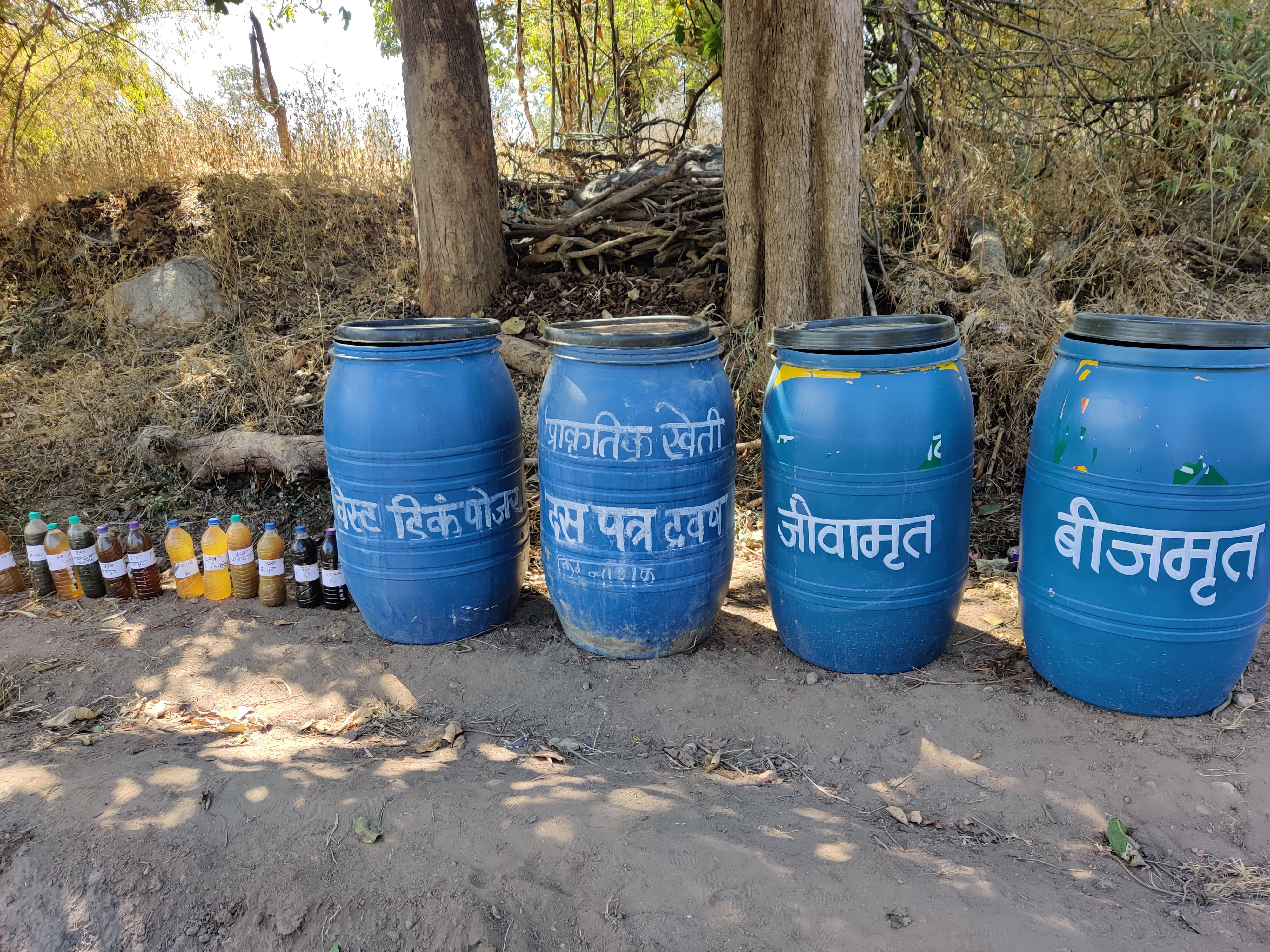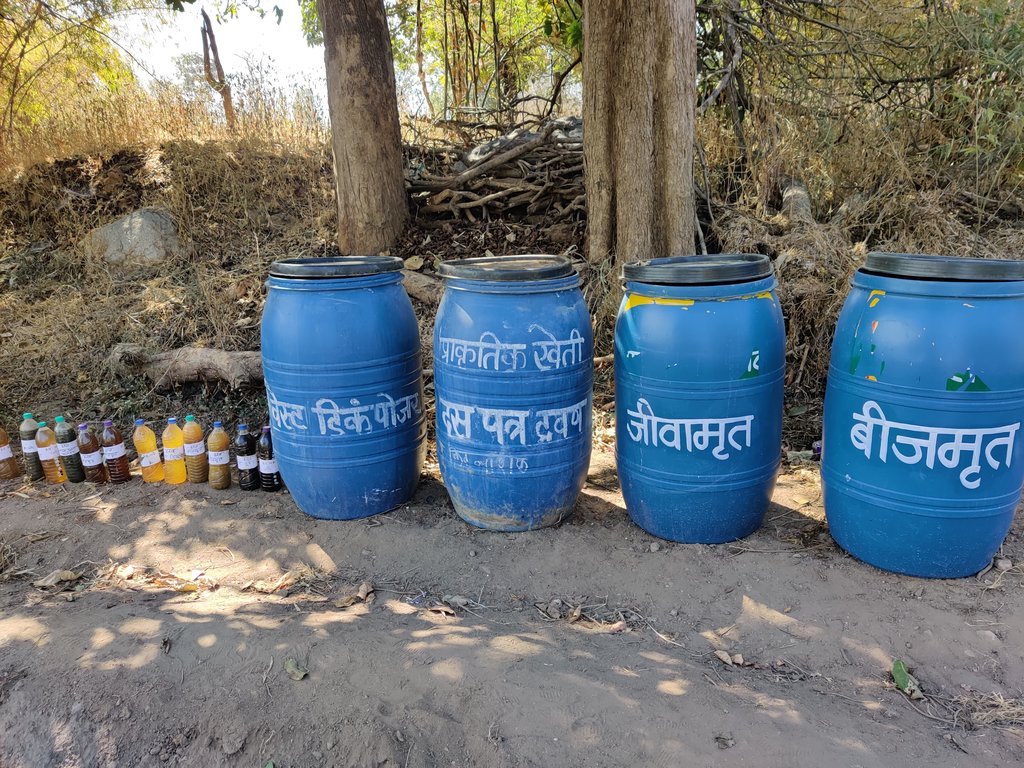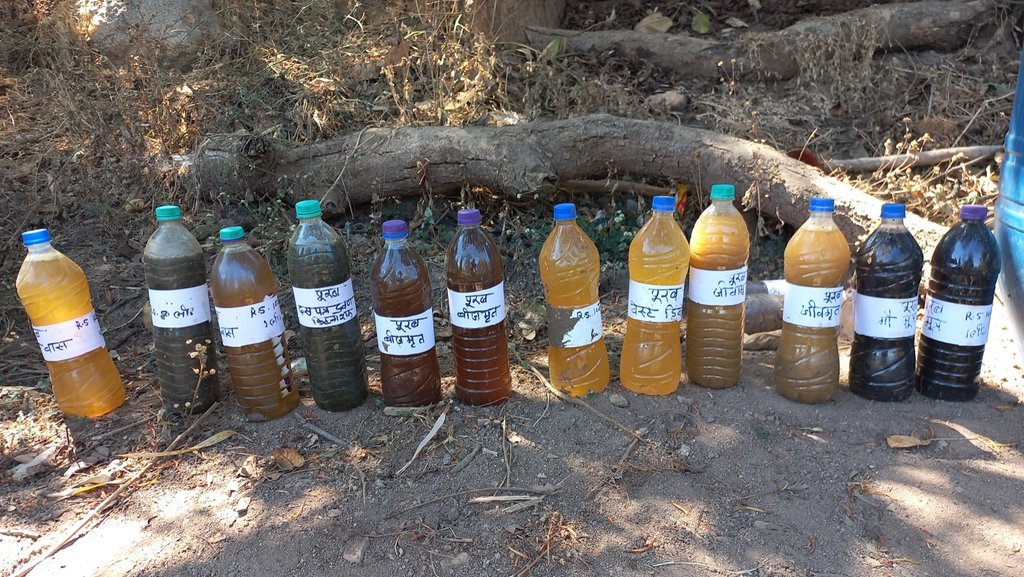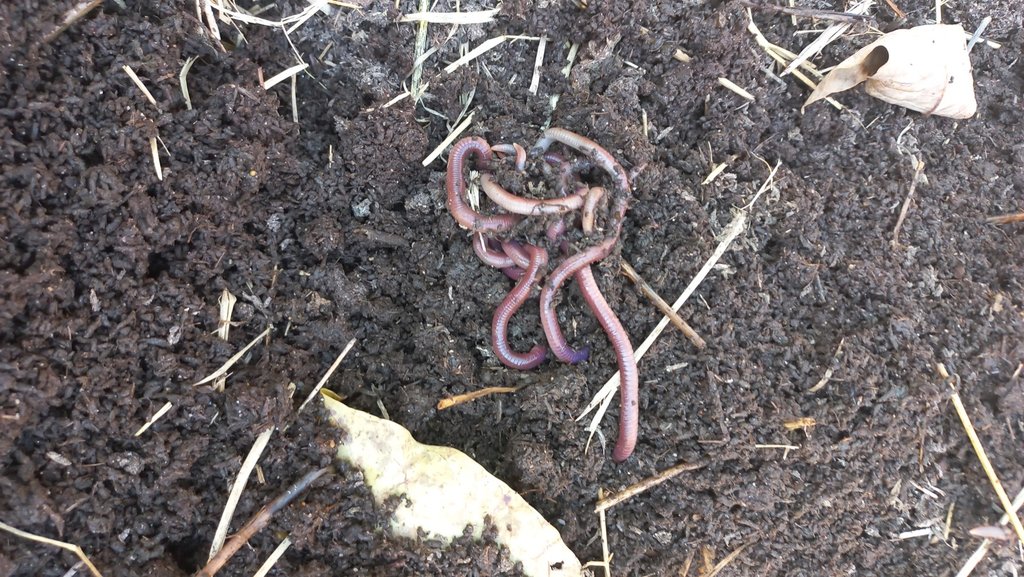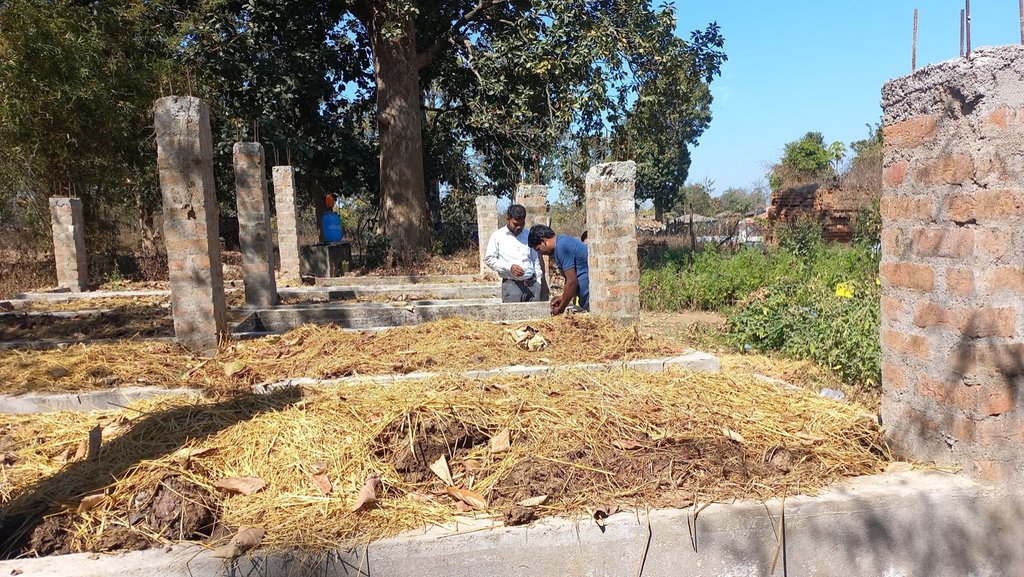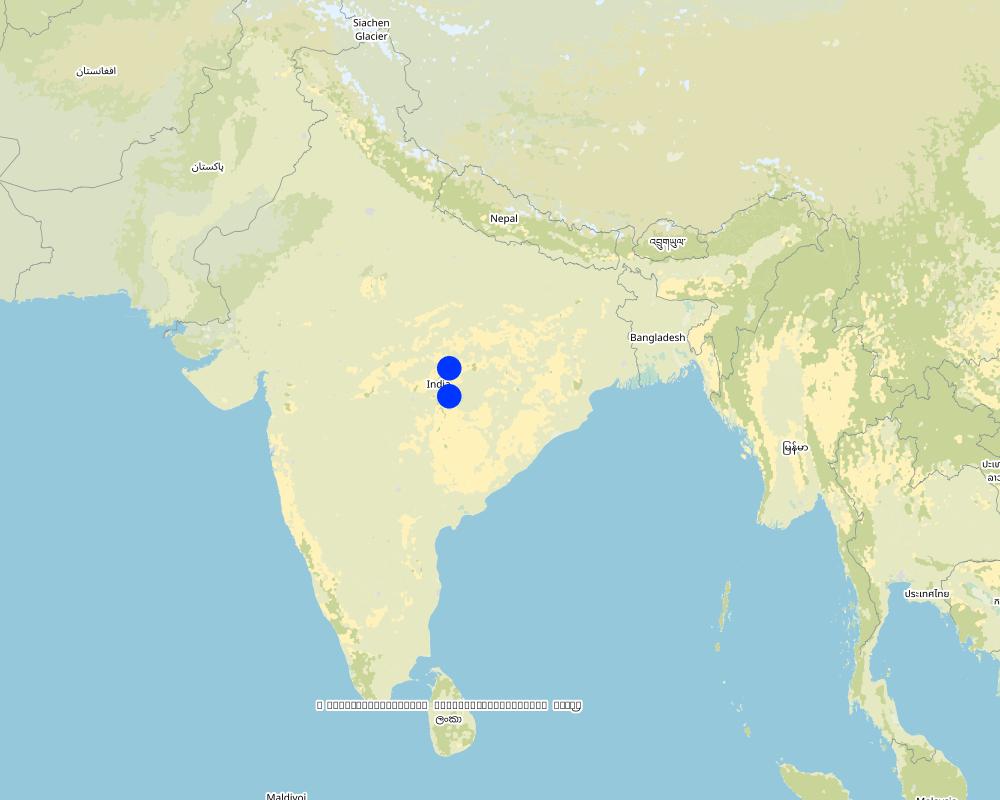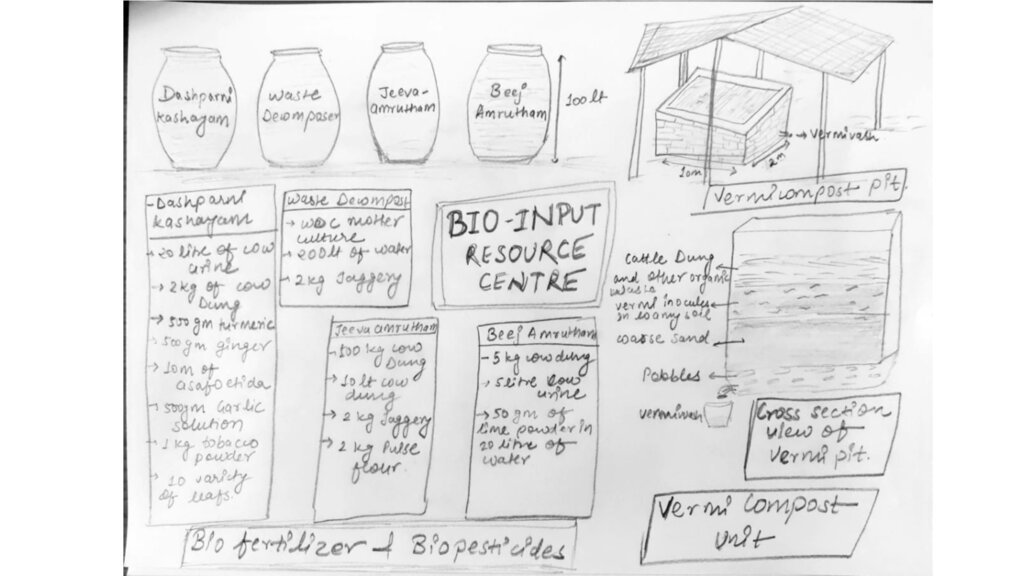Preparation of Bio-Inputs such as Vermicompost, Biofertilizers, and Biopesticides [Энэтхэг]
- Шинийг нээх:
- Шинэчлэх:
- Эмхэтгэгч: Santosh Gupta
- Хянан тохиолдуулагчид: Noel Templer, Stephanie Katsir, Kim Arora
- Хянагч: Udo Höggel
Kechua khaad, Beej Amrutham, Jeevamrutham, Dashparni and compost
technologies_6695 - Энэтхэг
- Бүрэн хураангуйн PDF хувилбар
- Бүрэн хураангуйг PDF-ээр хэвлэх
- Хөтөч дэх бүрэн хураангуй
- Бүрэн хураангуй (форматгүй)
- Preparation of Bio-Inputs such as Vermicompost, Biofertilizers, and Biopesticides: 25 6-р сар 2023 (inactive)
- Preparation of Bio-Inputs such as Vermicompost, Biofertilizers, and Biopesticides: 14 9-р сар 2023 (inactive)
- Preparation of Bio-Inputs such as Vermicompost, Biofertilizers, and Biopesticides: 17 4-р сар 2024 (public)
Бүлгүүдийг үзэх
Бүгдийг дэлгэх Бүгдийг хаах1. Ерөнхий мэдээлэл
1.2 Технологийг үнэлэх, баримтжуулах ажилд хамаарах мэдээлэл өгсөн хүмүүс, байгууллагуудын холбоо барих мэдээлэл
Технологи баримтжуулах/үнэлэх ажилд дэмжлэг үзүүлсэн байгууллага(ууд)-ын нэр (шаардлагатай бол)
Deutsche Gesellschaft für Internationale Zusammenarbeit (GIZ) GmbH (GIZ) - ГерманТехнологи баримтжуулах/үнэлэх ажилд дэмжлэг үзүүлсэн байгууллага(ууд)-ын нэр (шаардлагатай бол)
Alliance Bioversity and International Center for Tropical Agriculture (Alliance Bioversity-CIAT) - КениТехнологи баримтжуулах/үнэлэх ажилд дэмжлэг үзүүлсэн байгууллага(ууд)-ын нэр (шаардлагатай бол)
Ecociate Consultants (Ecociate Consultants) - Энэтхэг1.3 ВОКАТ-аар баримтжуулсан өгөгдлийг ашиглахтай холбоотой нөхцөл
Эмхэтгэгч болон гол мэдээлэгч хүн(хүмүүс) WOCAT аргачлалаар баримтжуулсан мэдээллийг ашиглахтай холбоотой нөхцлийг хүлээн зөвшөөрсөн:
Тийм
1.4 Технологи тогтвортой гэдгийг баталгаажуулах
Энэ технологийг газрын доройтлыг бууруулж, газрын тогтвортой менежментийг хангахад тохиромжтой гэж үзэж болох уу?
Үгүй
2. ГТМ Технологийн тодорхойлолт
2.1 Технологийн товч тодорхойлолт
Технологийн тодорхойлолт:
Bioresource Center (BRC) is an enterprise model to promote the preparation and commercialization of bio-inputs to help farmers adopt natural and sustainable agriculture practices. The bio-inputs and composting material under such models are prepared using locally available material at very affordable prices.
2.2 Технологийн дэлгэрэнгүй тодорхойлолт
Тодорхойлолт:
Bioresource Center (BRC) is a community-led enterprise to produce bio-inputs and compost from locally available bioresources for improving soil health and fertility, managing pest and disease, and meeting the nutrient requirement for the crops. BRCs have been envisaged as a potential enterprise solution to meet the requirements of small and marginal farmers who do not have time and resources to make their own bio-inputs and composting material. Such farmers can purchase the bio-inputs at very affordable prices from the BRCs being operated by either individual entrepreneurs or community-based institutions of male and female farmers.
Essentially it is an enterprise-led platform that can create the necessary conditions to scale the adoption of better farming practices. The technology for bioresource units is applied in both natural and human environments to promote sustainable agriculture and improve livelihoods in rural communities. The establishment and maintenance of a bioresource unit require inputs such as organic waste materials, earthworms, inoculants, and water, as well as activities such as vermicomposting, biofertilizer and biopesticide production, training and capacity building, and monitoring and evaluation.
The technological inputs produced include various type of tried and tested local formulations like microbial preparations such as Jeevamrut (Soil life elixir), Ghana Jeevamrith(compact and aggregated form of Soil Life Elixir), Beejamrut (Microbial Seed Dressing), Waste Decomposer, etc.; botanical decoctions like Panchagavya ( 5 cow based products formulation - Milk, Curd, cow-urine, cow-dung, ghee), Dashparni (Extract of 10 leaves available locally), Neemastra (Extarct of Neem leaves and seeds (Azadirachta indica), Brahmastra (Referes to the highly effective pest controlling material made out of chilli, garlic and other local materials), agniastra (Refers to the fire powering material for controlling pest), NSKE (Neem seed kernel extract) ; and biopesticides cultures like Beauveria, Verticillium, Trichoderma, Pseudo-monas, NPV formulations/cultures. Beyond this, the platform enables the supply of seeds of green manuring crops, vermiculture/compost, Neem / karanj cake, Cow dung/cow urine, briquets, seeds/seedlings of trap crops, etc. For a detailed list of different sub-technologies - preparations, their ingredients and processing one can refer to BIO-INPUT RESOURCE CENTER MANUAL FROM NATIONAL COALITION FOR NATURAL FARMING at: (https://indiaclimatecollaborative.org/wp-content/uploads/2022/09/BRC-Technical-manual.pdf)
This technology does not require much investment and material. 2-3 plastic containers of 200 litres and 2-3 containers of 100 litres or any other locally available utensil are good enough to make these bio-inputs. The preparation method for each of the inputs is a bit different from each other, while some of the inputs are being prepared by extracting the paste from leaves or other materials like chilli, garlic etc, others are prepared by mixing them with cow dung and cow urine. Cow urine is one of the most important substances for preparing these inputs. The urine of indigenous cows are considered more effective for preparing these inputs. The document shared above can be refereed to for the preparation method of each of the bio-inputs.
The bioresource unit technology has numerous benefits and impacts, including improved soil health, reduced dependence on synthetic inputs, increased crop yields, reduced environmental impact, enhanced biodiversity, reduced greenhouse gas emissions, and improved human health. Land users generally appreciate the benefits of the bioresource unit technology, particularly its cost-effectiveness, improved soil health, and reduced environmental impact. However, there are also challenges related to the labor-intensiveness of the technology, the need for technical knowledge, and the dependence on local resources.
By using natural inputs and locally available resources, this technology can help to create a more sustainable and equitable food system for people and for land also. These functions contribute to a healthier environment, healthier crops, and healthier communities.
2.3 Технологийн гэрэл зураг
Гэрэл зурагтай холбоотой ерөнхий тэмдэглэл:
All the photos have been taken with consents of participants
2.4 Технологийн дүрс бичлэг
Тайлбар, товч тодорхойлолт:
Video of the technology
https://www.youtube.com/watch?v=hW2xEpWyIa8
Hindi narration of the bioinput resource center during the field visit.
Он, сар, өдөр:
19/03/2023
Байршил:
Mandla, Madhya Pradesh, India
Зураглаачийн нэр:
Santosh Gupta
2.5 Энэ үнэлгээнд хамрагдсан технологийг хэрэгжүүлсэн улс орон/ бүс нутаг/ байршил
Улс:
Энэтхэг
Улс/аймаг/сум:
Madhya Pradesh
Байршлын дэлгэрэнгүй тодорхойлолт:
Bichhiya Block, Mandla District, Madhya Pradesh
Технологи өргөн дэлгэрсэн эсхийг тодорхойл:
- тодорхой газар хэрэгжсэн/ жижиг талбайд төвлөрсөн
Технологи(иуд) нэвтрүүлсэн талбай тусгай хамгаалалттай газар нутагт байрладаг уу?
Үгүй
Тайлбар:
The technology was implemented in some of the selected villages of the Bichhiya Block in the Mandla District of Madhya Pradesh. These villages are located in and around a tiger reserve park.
Map
×2.6 Хэрэгжсэн хугацаа
Хэрэгжүүлсэн он:
2018
2.7 Технологийн танилцуулга
Технологийг хэрхэн нэвтрүүлснийг тодорхойл:
- Газар ашиглагчдын санаачилгаар
- Туршилт/судалгааны үр дүн
- Гадны төсөл/хөтөлбөрийн дэмжлэгтэйгээр
3. ГТМ технологийн ангилал
3.1 Технологийн үндсэн зорилго (ууд)
- үйлдвэрлэлийг сайжруулах
- газрын доройтлыг бууруулах, сэргийлэх, нөхөн сэргээх
- экосистемийг хамгаалах
- биологийн төрөл зүйлийг хамгаалах / сайжруулах
- уур амьсгалын өөрчлөлт/ экстрим байдал болон түүний нөлөөлөлд дасан зохицох
- үр ашигтай эдийн засгийн нөлөөг бий болгох
- Control pest and diseases
3.2 Технологи нэвтрүүлсэн газрын одоогийн газар ашиглалтын хэлбэр(үүд)
Нэг газр нутгийн хэмжээнд хэрэгжих холимог газар ашиглалт:
Үгүй

Тариалангийн талбай
- Нэг наст үр тариа
Нэг наст үр тариа - Таримлыг тодорхойлно уу:
- үр тариа - эрдэнэ шиш
- үр тариа - цагаан будаа (чийгт газрын)
- үр тариа - улаан буудай (өвлийн)
- буурцагт ургамал - сэвэг зарам
- тосны ургамал - наран цэцэг, рапс ба бусад
- хүнсний ногоо - навчит ургамал (салат, байцаа, бууцай, бусад)
Жилд ургамал ургах улирлын тоо:
- 2
Тодорхойлно уу:
During the monsoon, farmers are cultivating the rice while during the winter season they are growing wheat, chick-pea, mustard and other crops
Сөөлжлөн тариалалт хийгддэг үү?
Тийм
Хэрэв тийм бол ямар таримлыг сөөлжлөн тариалдаг вэ?
Chick pea intercropped with beans, mixed cropping system of vegetables
Таримлыг ээлжлэн тариалдаг уу?
Тийм
Хэрэв тийм бол, тодруулна уу:
Rice-Chick pea, Rice-Wheat
Тайлбар:
The technology has enabled farmers to get easy access to bio-inputs, which has led to the adoption of natural and sustainable farming practices in the field. This has also promoted mixed farming systems among the farmers as natural farming is more suited to such cropping systems.
3.3 Технологи хэрэгжүүлснээр газар ашиглалтад өөрчлөлт гарсан уу?
Технологи хэрэгжүүлснээр газар ашиглалтад өөрчлөлт гарсан уу?
- Үгүй (3.4 руу шилжинэ үү)
Тайлбар:
The land use pattern remained same. Farmers are cultivating the crops both before and after the intervention.
3.4 Усан хангамж
Технологи хэрэгжүүлсэн газрын усан хангамж:
- Байгалийн/усалгаатай арга хосолсон
Тайлбар:
Most farmers cultivate under rainfed conditions due to the unavailability of any external irrigation facility. There are a few farmers who apply irrigation.
3.5 Технологи ГТМ-ийн аль бүлэгт хамаарах вэ
- Тариалан-мал аж ахуйн нэгдсэн менежмент
- Хөрсний үржил шимийн нэгдсэн менежмент
- Хортон ба өвчний нэгдсэн менежмент (органик газар тариаланг хамруулна)
3.6 Технологийг бүрдүүлэх ГТМ арга хэмжээ

Агрономийн арга хэмжээ
- А2: Органик нэгдэл/ хөрсний үржил шим
- А4: Хөрсний үе давхаргыг сайжруулах
- А6: Хагд өвсний менежмент
А6: Хагд өвсний менежментийг тодорхойлно уу:
А 6.4: хадгалсан

бусад арга хэмжээ
Тодорхойлно уу:
Pest and diseases management measures to reduce the use of chemical fertilizers and pesticides
Тайлбар:
Bio-inputs are an effective alternative to reduce or replace the use of synthetic fertilisers and pesticides. The use of these inputs ensure lesser pollution of air and water, safe food and improved biodiversity.
3.7 Технологид харгалзах газрын доройтлын төрөл

хөрсний химийн доройтол
- Cn: Үржил шим ба ялзмаг буурах (элэгдлийн шалтгаангүй)
- Cp: Хөрсний бохирдол

биологийн доройтол
- Bp: Хортон шавьж/өвчлөл ихсэх, махчид цөөрөх

усны доройтол
- Hp: Гадаргын усны чанар муудах
Тайлбар:
Control over pest and disease along with improved soil microbial activity as an outcome of vermicompost application has ensured better soil health and improved production.
3.8 Газрын доройтлоос урьдчилан сэргийлэх, сааруулах ба нөхөн сэргээх
Газрын доройтолтой холбоотойгоор Технологи ямар зорилго тавьсан болохыг тодорхойл:
- Газрын доройтлыг бууруулах
4. Техникийн нөхцөл, хэрэгжүүлсэн үйл ажиллагаа, материал ба зардал
4.1 Технологийн техник зураг
Техник тодорхойлолт (техник зургийн тайлбар):
The drawing indicates the overall flow and design of the bioresource unit as seen in one of the enterprises in the project area. It consists of vermicompost pits of 6ft in length, 4 ft in depth, and 2 ft in width. The enterprise has 10 such pits. The drawing also covers the placement and structure of other equipment such as vermiwash and bio-inoculate units.
Зохиогч:
Payal
Он, сар, өдөр:
08/03/2023
4.2 Материал болон зардалд хамаарах ерөнхий мэдээлэл
Үнэ өртөг, оруулсан хувь нэмрийг хэрхэн тооцсоныг тодорхойл:
- Технологийн нэгж тус бүр
Нэгжийг тодорхойл:
Vermicompost unit is a pit, biofertilizer and pesticides unit in litre, Materials is in Kg
Хэрэв боломжтой бол үндэсний валютын Америк доллартай харьцах харьцааг бичнэ үү (тухайлбал, 1 ам.дол. = 79,9 Бразил реал): 1 ам.дол. =:
82.0
Хөлсний ажилчны нэг өдрийн цалингийн хэмжээг тодорхойлно уу:
3
4.3 Бий болгох үйл ажиллагаа
| Үйл ажиллагаа | Хугацаа (улирал) | |
|---|---|---|
| 1. | Digging for vermicompost pits | October |
| 2. | Construction of vermicompost pit | October |
| 3. | Construction of Cattle Management Shed | March |
4.4 Бий болгоход шаардагдсан зардал, хөрөнгийн өртөг
| Зардлын нэр, төрөл | Хэмжих нэгж | Тоо хэмжээ | Нэгжийн үнэ | Зардал бүрийн нийт өртөг | Нийт дүнгээс газар ашиглагчийн төлсөн % | |
|---|---|---|---|---|---|---|
| Хөдөлмөр эрхлэлт | Digging for vermicompost pit | piece | 2.0 | 1000.0 | 2000.0 | 100.0 |
| Хөдөлмөр эрхлэлт | Construction of vermicompost pit | piece | 2.0 | 4000.0 | 8000.0 | 100.0 |
| Тоног төхөөрөмж | Drum 500 lts | piece | 5.0 | 600.0 | 3000.0 | 100.0 |
| таримал материал | Pulse flour | Kg | 3.0 | 70.0 | 210.0 | 100.0 |
| таримал материал | Jageery | Kg | 3.0 | 60.0 | 180.0 | 100.0 |
| таримал материал | Turmeric | Kg | 0.5 | 100.0 | 50.0 | 100.0 |
| таримал материал | Ginger paste | Kg | 0.5 | 120.0 | 60.0 | 100.0 |
| таримал материал | Asafoetida | Gramm | 10.0 | 3.0 | 30.0 | 100.0 |
| таримал материал | Chillies | Kg | 1.0 | 100.0 | 100.0 | 100.0 |
| таримал материал | Garlic | Kg | 0.5 | 160.0 | 80.0 | 100.0 |
| таримал материал | Tobbaco | Kg | 0.5 | 200.0 | 100.0 | 100.0 |
| Бордоо ба биоцид | Cow dung | Kg | 120.0 | 2.0 | 240.0 | 100.0 |
| Бордоо ба биоцид | Cow urine | Litre | 25.0 | 5.0 | 125.0 | 100.0 |
| Бордоо ба биоцид | Lime | Gramm | 50.0 | 0.25 | 12.5 | 100.0 |
| Бордоо ба биоцид | Farm Yard Manure for Vermicompost | Kg | 1000.0 | 10.0 | 10000.0 | 100.0 |
| Барилгын материал | Brick | Piece | 100.0 | 10.0 | 1000.0 | 100.0 |
| Барилгын материал | Cement | Sack | 3.0 | 300.0 | 900.0 | 100.0 |
| Барилгын материал | Stone | Sack | 2.0 | 500.0 | 1000.0 | 100.0 |
| Бусад | Vermi inocules | Kg | 40.0 | 450.0 | 18000.0 | 100.0 |
| Технологи бий болгох нийт үнэ өртөг | 45087.5 | |||||
| Технологи бий болгох нийт үнэ өртөг, ам.доллар | 549.85 | |||||
4.5 Арчилгаа/ урсгал үйл ажиллагаа
| Үйл ажиллагаа | Хугацаа/ давтамж | |
|---|---|---|
| 1. | Preparations | Every season |
| 2. | Packaging and Selling | Everyseason |
| 3. | Capacity building | Every season |
| 4. | Application at field | Kharif and Rabi Seaon |
| 5. | Harvesting of vermicompost | In every 3 months |
| 6. | Filling of pit | In every 3 months after Harvesting |
4.6 Арчилгаа/урсгал ажилд шаардагдсан зардал, хөрөнгийн өртөг (нэг жилд)
| Зардлын нэр, төрөл | Хэмжих нэгж | Тоо хэмжээ | Нэгжийн үнэ | Зардал бүрийн нийт өртөг | Нийт дүнгээс газар ашиглагчийн төлсөн % | |
|---|---|---|---|---|---|---|
| Хөдөлмөр эрхлэлт | Preparation of bio-inputs | Person days | 50.0 | 200.0 | 10000.0 | 100.0 |
| Хөдөлмөр эрхлэлт | Packaging, marketing | Person days | 10.0 | 250.0 | 2500.0 | 100.0 |
| Бордоо ба биоцид | Cow dung or FYM for filling pit | Kg | 100.0 | 10.0 | 1000.0 | 100.0 |
| Бордоо ба биоцид | Different material to prepare bio-inputs | kg | 200.0 | 15.0 | 3000.0 | 100.0 |
| Бусад | Packaging and Selling | Sack | 100.0 | 5.0 | 500.0 | 100.0 |
| Технологийн арчилгаа/урсгал үйл ажиллагаанд шаардагдах нийт үнэ өртөг | 17000.0 | |||||
| Технологи арчилах ба урсгал ажлын нийт үнэ өртөг, ам.доллар | 207.32 | |||||
Тайлбар:
After harvesting of vermicompost, maintenance of the pit is required by refilling pit with farm yard manure (FYM). For selling biofertilizers and biopesticides new batch preparation incl. all input materials is required.
4.7 Зардалд нөлөөлж байгаа хамгийн чухал хүчин зүйл
Өртөг, зардалд нөлөөлөх гол хүчин зүйл:
The availability of locally available raw materials and labor
5. Байгаль ба нийгмийн нөхцөл
5.1 Уур амьсгал
Жилийн нийлбэр хур тундас
- < 250 мм
- 251-500 мм
- 501-750 мм
- 751-1,000 мм
- 1,001-1,500 мм
- 1,501-2,000 мм
- 2,001-3,000 мм
- 3,001-4,000 мм
- > 4,000 мм
Жилийн дундаж хур тунадас (хэрэв мэдэгдэж байвал), мм:
1427.00
Хур тунадасны талаархи тодорхойлолт/ тайлбар:
The highest rainfall period is from June to September during the monsoon season.
Холбогдох цаг уурын станцын нэр:
Mandla, Madhya Pradesh
Агро-уур амьсгалын бүс
- хагас хуурай
The climate of the district is tropical, with moderate winters, severe summers, and well-distributed rainfall received from the southwest monsoon. However, due to higher general elevation and abundance of forests, summer temperatures do not rise as much as in other areas.
5.2 Гадаргын хэлбэр
Дундаж налуу:
- хавтгай (0-2 %)
- бага зэрэг налуу (3-5 %)
- дунд зэрэг налуу (6-10 % )
- хэвгий (11-15 %)
- налуу (16-30 %)
- их налуу (31-60 % )
- эгц налуу (>60 %)
Гадаргын хэлбэр:
- тэгш өндөрлөг / тал
- нуруу
- уулын энгэр
- дов толгод
- бэл
- хөндий
Өндрийн бүслүүр:
- 0-100 д.т.д. м.
- 101-500 д.т.д. м.
- 501-1,000 д.т.д м.
- 1,001-1,500 д.т.д м.
- 1,501-2,000 д.т.д м.
- 2,001-2,500 д.т.д. м.
- 2,501-3,000 д.т.д. м.
- 3,001-4,000 д.т.д м.
- > 4,000 д.т.д. м.
Технологи дараах асуудалд хандсан эсэхийг тодорхойл:
- хамааралгүй
Гадаргын талаархи тодорхойлолт ба бусад тайлбар:
The topography of the project area consists of a hilly area and a forest area. Mandla district is hilly and forested (Satpura hill range) and highly undulating with a narrow strip of cultivated plains in the valley portion of the river. The plateau is in the northern part formed by basalt, and east-west trending hills in the southern part. The highest elevation is 934 m amsl in the northern part, and the lowest is around 400 m amsl in the northwestern part of the area. The elevation of the studied block Bichhiya is 453 m amsl.
Source: District at a glance; Ministry of water resources, Government of Madhya Pradesh
5.3 Хөрс
Хөрсний дундаж зузаан:
- маш нимгэн (0-20 см)
- нимгэн (21-50 см)
- дунд зэрэг зузаан (51-80 см)
- зузаан (81-120 cм)
- маш зузаан (>120 cм)
Хөрсний бүтэц (өнгөн хөрс):
- бүдүүн/ хөнгөн (элсэрхэг)
- дундаж (элсэнцэр, шавранцар)
Хөрсний бүтэц (>20 см-ээс доош):
- дундаж (элсэнцэр, шавранцар)
Өнгөн хөрсөнд агуулагдах ялзмаг:
- бага (<1 % )
Боломжтой бол хөрсний бүрэн тодорхойлолт, боломжит мэдээллийг өгнө үү, жишээ нь хөрсний төрөл, хөрсний урвалын орчин/хүчиллэг байдал, катион солилцох чадавхи, азотын хэмжээ, давсжилт г.м.
Soil Testing Parameter status (Average) 2017-20 for the project areas is as follows. This data is based on the soil samples tested by the FES in its soil labs from the project villages:
Soil pH:- 5.906548628; EC (electrical conductivity):- 0.122993577; Soil Organic Carbon:- 0.83%; Nitrogen:- 293.3696598; Phosphorus:- 25.77762582; Potassium (K):- 139.6696636; Sulphur (S):-18.93457993; Zinc (Zn):- 0.955246706; Boron (Bn):- 0.490850376
5.4 Усны хүртээмж ба чанар
Гүний усны түвшин:
> 50 м
Гадаргын усны хүртээмж:
дунд зэрэг
Усны чанар (цэвэршүүлээгүй):
муу чанарын ундны ус (цэвэршүүлэх шаардлагатай)
Усны чанар гэж:
гадаргын ба газрын доорхи ус
Усны давсжилтын асуудал бий юу?
Үгүй
Энэ газар үерт автдаг уу?
Үгүй
Усны чанар, нөөцийн талаархи тайлбар ба бусад тодорхойлолт:
The groundwater status is within the safe limits as per the reports by the Government of Madhya Pradesh. People use water from rivers, streams, and traditional small wells for domestic purposes. In the absence of good vegetative cover, the rainwater washes off the fertile topsoil from the farmlands making the land barren and resulting in the siltation of ponds and other water bodies. Further, a heavy infestation of invasive species such as Lantana Camara compounds the degradation.
The studied block Bichhiya is in a better position in terms of stage of groundwater Development with 17%, while the district average is 7%.
Source: http://cgwb.gov.in/District_Profile/MP/Mandla.pdf
5.5 Биологийн олон янз байдал
Зүйлийн олон янз байдал:
- Их
Амьдрах орчны олон янз байдал:
- Их
Биологийн олон янз байдлын талаархи тайлбар ба бусад тодорхойлолт:
The bio-input resource unit or center is present nearby the forest area of Kanha National Park. The high biodiversity present in the technology implementation area. Ecological assessment report in Mandla (where this Technology is applied) showed improved biodiversity on common lands under village governance compared to open-access or commons under government ownership. On average, the Shannon diversity index of managed common lands was 1.45 compared to 0.42 for the open access or ungoverned commons. Most of the sites under open access lands are infested by Lantana camara, which is the main reason for the lower biomass and diversity of the ungoverned lands.
5.6 Технологи нэвтрүүлсэн газар ашиглагчдын тухай мэдээлэл
Суурьшмал эсвэл нүүдлийн:
- Суурьшмал
Үйлдвэрлэлийн системийн зах зээлийн чиг баримжаа:
- холимог (амьжиргаа ба худалдаанд)
Бусад эх үүсвэрээс олох орлого:
- Нийт орлогын 50 %-иас дээш
Чинээлэг байдлын түвшин:
- ядуу
Хувь хүн эсвэл бүлэг:
- бүлэг / олон нийтийн
Механикжилтын түвшин:
- гар ажил
- ердийн хөсөг
Хүйс:
- эмэгтэй
- эрэгтэй
Газар ашиглагчийн нас:
- залуус
- дунд нас
5.7 Газар ашиглагчийн технологи нэвтрүүлсэн газрын дундаж талбайн хэмжээ
- < 0.5 га
- 0.5-1 га
- 1-2 га
- 2-5 га
- 5-15 га
- 15-50 га
- 50-100 га
- 100-500 га
- 500-1,000 га
- 1,000-10,000 га
- > 10,000 га
Энэ талбай том, жижиг, дунд алинд хамаарах вэ (орон нутгийн нөхцөлд харгалзуулна уу)?
- бага-хэмжээний
Тайлбар:
The bio-inputs are being prepared by more than 100 users and applied by 1000 farmers in their fields as part of the intervention. There are around 20 enterprise units in the project area, which are preparing the bio-inputs and selling them to other farmers.
5.8 Газар эзэмшил, газар ашиглах эрх, ус ашиглах эрх
Газар өмчлөл:
- хувь хүн, өмчийн гэрчилгээтэй
Газар ашиглах эрх:
- хувь хүн
Ус ашиглах эрх:
- нэгдлийн хэлбэрээр (зохион байгуулалттай)
- хувь хүн
Газар ашиглах эрх нь уламжлалт эрхзүйн тогтолцоонд суурилсан уу?
Тийм
Тодорхойлно уу:
Some of the land parcels are ancestral land units while some have been transferred by the State Government over the years.
5.9 Дэд бүтэц, үйлчилгээний хүртээмж
эрүүл мэнд:
- ядуу
- дунд зэргийн
- сайн
боловсрол:
- ядуу
- дунд зэргийн
- сайн
техник зөвлөгөө:
- ядуу
- дунд зэргийн
- сайн
хөдөлмөр эрхлэлт (жишээ нь, ХАА-аас өөр):
- ядуу
- дунд зэргийн
- сайн
зах зээл:
- ядуу
- дунд зэргийн
- сайн
эрчим хүчний хангамж:
- ядуу
- дунд зэргийн
- сайн
зам тээвэр:
- ядуу
- дунд зэргийн
- сайн
усан хангамж ба ариутгал:
- ядуу
- дунд зэргийн
- сайн
санхүүгийн үйлчилгээ:
- ядуу
- дунд зэргийн
- сайн
6. Үр нөлөө ба дүгнэлт
6.1 Технологийн талбайд үзүүлсэн нөлөө
Нийгэм-эдийн засгийн үр нөлөө
Үйлдвэрлэл
газар тариалангийн үйлдвэрлэл
Тайлбар/ тодорхой дурьдах:
The use of compost, bio-fertilisers and other nutrient-rich material has improved farm productivity to a great extent
үр тарианы чанар
Тайлбар/ тодорхой дурьдах:
Improvement in crop quality such as size of the grains and vegetables, nutrient content, their aroma has improved due to application of inputs made at BRC
бүтээмж буурах эрсдэл
Тайлбар/ тодорхой дурьдах:
The local material including the local seeds are more resilient to the extreme climatic events and offer a reduced risk to the farmers
бүтээгдэхүүний олон янз хэлбэр
Орлого, зарлага
ХАА-н зардал
Тайлбар/ тодорхой дурьдах:
Use of local materials, low-tech home-based processing, and open source availability of technology enables farmers to produce their organic inputs at home essentially only costing capital such as plastic container and labour, thus improving the accessibility of good farming inputs to even disadvantaged groups such as small farmers, marginalised communities, landless farmers, ultra-poor, etc.
тухайн аж ахуйн орлого
Тайлбар/ тодорхой дурьдах:
Farmers have reported of getting better prices for their produces produced with low or no chemical inputs
орлогын олон янз эх үүсвэр
Тайлбар/ тодорхой дурьдах:
BRC as an enterprise activity offered an additional source of income to the farmers
Нийгэм-соёлын үр нөлөө
хүнсний аюулгүй байдал/ өөрийн хэрэгцээг хангах
эрүүл мэндийн байдал
Тайлбар/ тодорхой дурьдах:
Lesser use of chemical fertilizers and pesticides improve the negative impact of these on human and animal health
соёлын боломжууд
Тайлбар/ тодорхой дурьдах:
Cultural opportuities develop through livestock integration, concoction preparations and an improvemetn of the local economy
олон нийтийн институц
ГТМ/ газрын доройтлын мэдлэг
нийгэм, эдийн засгийн хувьд эмзэг бүлгийнхний нөхцөл байдал
Экологийн үр нөлөө
Усны эргэлт/ илүүдэл
усны чанар
Тайлбар/ тодорхой дурьдах:
Use of chemical based intensive farming has proven to be disastrous for water quality and strenuous for water quantity. The BRCs help farmers adopt biological means of improving fertility and reducing pest damage and have no long-term polluting effect on groundwater and canal resources. Adoption of sustainable agriculture practices that effectively substitute chemicals, improve as well natural resource cycles have been shown to improve water availability in the field and thus also improve water use efficiency.
гадаргын урсац
Хөрс
хөрсний чийг
хөрс алдагдах
шимт бодисын эргэлт/ сэргэлт
хөрсний органик нэгдэл/ хөрсөнд агуулагдах карбон
Биологийн олон янз байдал: ургамал, амьтан
газрын дээрхи / доорхи карбон
ургамлын төрөл, зүйл
амьтны төрөл, зүйл
ашигт төрөл зүйл
Тайлбар/ тодорхой дурьдах:
Reduced usage of chemical pesticides prevent loss of beneficial insects and micro organisms, thus improve the population of beneficial species
амьдрах орчны олон янз байдал
Тайлбар/ тодорхой дурьдах:
Reduced usage of chemical pesticides prevent loss of beneficial insects and micro organisms, thus improve the overall farm diversity
хортон шавж/өвчний хяналт
Тайлбар/ тодорхой дурьдах:
This technology is meant for pest/disease control purposes. The usage of these inputs is very effective in controlling the pest and diseases.
Уур амьсгал болон гамшгийн эрсдлийг бууруулах
нүүрстөрөгч ба хүлэмжийн хийн ялгаруулалт
Тайлбар/ тодорхой дурьдах:
Emission reductions happen through substitution of chemical inputs. Agri chemicals have high emission intensity in production, transportation and use. Studies show that the use of urea contributes to higher methane emissions because of ammonia decomposition.
Carbon sequestration benefits are also achieved because of the increase in SOC by adopting natural inputs, higher photosynthetic efficiency, more microbial carbon use efficiency and improved residue cycling.
6.2 Технологийн талбайн гадна үзүүлсэн үр нөлөө
газар доорхи ус/голын усны бохирдол
хөрш зэргэлдээ газарт учирах хохирол
Тайлбар/ тодорхой дурьдах:
Adoption of this tech means reduced chemical runoff, better biodiversity supporting neighbouring fields and providing other ecosystem services.
хүлэмжийн хийн нөлөө
Тайлбар/ тодорхой дурьдах:
Emission reductions happen through substitution of chemical inputs. Agri chemicals have high emission intensity in production, transportation and use. Studies show that the use of urea contributes to higher methane emissions because of ammonia decomposition.
Carbon sequestration benefits are also achieved because of increase in SOC by adopting natural inputs, higher photosynthetic efficiency, more microbial carbon use efficiency and improved residue cycling.
6.3 Технологийн уур амьсгалын өөрчлөлт, цаг агаарын гамшигт үзэгдэлд өртөх байдал ба эмзэг байдал (газар ашиглагчийн бодлоор)
Уур амьсгалын аажим өөрчлөлт
Уур амьсгалын аажим өөрчлөлт
| Улирал | Өсөх эсвэл буурах | Технологи түүний нөлөөг хэрхэн бууруулж байна? | |
|---|---|---|---|
| жилийн дундаж температур | Өсөлт | дунд зэрэг | |
| улирлын температур | зун | Өсөлт | дунд зэрэг |
| жилийн дундаж хур тундас | Бууралт | маш сайн |
6.4 Өртөг ба ашгийн шинжилгээ
Бий болгох зардалтай харьцуулахад ямар ашиг өгсөн бэ (газар ашиглагчийн бодлоор)?
Богино хугацаанд эргэн төлөгдөх байдал:
бага зэрэг эерэг
Урт хугацаанд эргэн төлөгдөх байдал:
эерэг
Арчилгаа/урсгал зардалтай харьцуулахад ямар ашиг өгсөн бэ (газар ашиглагчийн бодлоор)?
Богино хугацаанд эргэн төлөгдөх байдал:
бага зэрэг сөрөг
Урт хугацаанд эргэн төлөгдөх байдал:
маш эерэг
6.5 Технологи нэвтрүүлэлт
- жишээ/ туршилт
Боломжтой бол, тоогоор илэрхийл (өрхийн тоо эсвэл бүрхэх талбай):
8
Технологи нэвтрүүлсэн хүмүүсээс хэд нь өөрийн хүчээр технологийг хэрэгжүүлсэн бэ, өөрөөр хэлбэл гадны тусламж дэмжлэг авалгүйгээр?
- 91-100%
6.6 Дасан зохицох
Бий болсон өөрчлөлтөд зохицуулан технологийг өөрчилсөн үү?
Тийм
Хэрэв Тийм бол ямар өөрчлөлтөд дасан зохицсон бэ:
- зах зээлийн өөрчлөлт
Дасан зохицох зорилгоор технологид хийсэн өөрчлөлт (хийц, материал, төрөл зүйл г.м.):
New variants of locally produced bio-based enzymes, catalysts, fertilizers, pest repellants
6.7 Технологийн давуу тал/боломжууд
| Газар ашиглагчдын тодорхойлсон давуу тал/боломжууд |
|---|
| The technologies reduce costs and increase savings. |
| Improved crop production and quality through sustainable management. |
| Reduces exposure to hazardous chemicals. |
| Эмхэтгэгч, бусад мэдээлэл өгсөн хүмүүсийн өнцгөөс тодорхойлсон давуу тал/боломжууд |
|---|
| Protection and sustainable use of local biodiverse resources. |
| Adoption of sustainable and organic practices. |
| Local circular economy and strengthened institutions. |
6.8 Технологийн дутагдалтай/сул тал/аюул болон тэдгээрийг хэрхэн даван туулах арга зам
| Газар ашиглагч нарын тодорхойлсон сул тал/ дутагдал/ эрсдэл | Тэдгээрийг хэрхэн даван туулах вэ? |
|---|---|
| Low demand for produced inputs. | Increase extension efforts for agroecological practices |
| Labor shortages. | Improved technologies and automation of production and delivery |
| Availability of raw materials. | Improved common land management |
| Эмхэтгэгч, бусад мэдээлэл өгсөн хүмүүсийн өнцгөөс тодорхойлсон сул тал/ дутагдал/ эрсдэл | Тэдгээрийг хэрхэн даван туулах вэ? |
|---|---|
| Disadoption threats. | Increase demand for products |
| Spurious input production. | Standardization and certification |
7. Ном зүй ба холбоосууд
7.1 Мэдээлэл цуглуулсан арга/эх үүсвэр
- Хээрийн уулзалт, судалгаа
10
- Газар ашиглагчтай хийсэн ярилцлага
5
- ГТМ-ийн мэргэжилтэн/шинжээчтэй хийсэн ярилцлага
1
Мэдээллийг хэзээ (газар дээр нь) цуглуулсан бэ?
21/02/2023
7.3 Холбогдох мэдээллийн интернет холбоос
Гарчиг/ тодорхойлолт:
Bio-input Resource Center Manual from National Coalition for Natural Farming
URL:
https://drive.google.com/file/d/1MpJGpyIm1oq1ro-GKvhJVNMqCSjkCE99/view?usp=share_link
Гарчиг/ тодорхойлолт:
Glimpse into the Bio-Input Resource Centre of South India by National Coalition for Natural Farming
URL:
https://www.youtube.com/watch?v=cfHeecl6OEo
Холбоос ба модулууд
Бүгдийг дэлгэх Бүгдийг хаахХолбоосууд
Холбоос байхгүй байна
Модулууд
Модуль байхгүй байна


